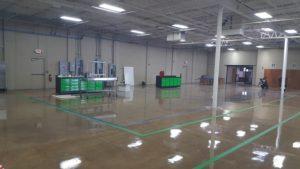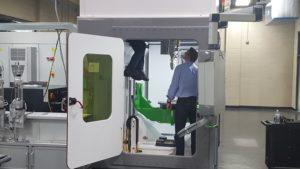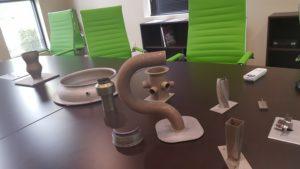BeAM Machines Looks to Open, Realistic Approach in Advancing Metal Additive Manufacturing: Exclusive Interview
 I think it’s safe to say that, collectively, we’re over the hype in additive manufacturing. 3D printing holds remarkable promise in leading the way for this next industrial revolution, allowing for geometries never before possible and customization at a new scale, but it’s not magic. So what is it? It’s progress, based on hard science backing new technologies. This realism is coming more into the picture lately, as industrial 3D printing begins to take hold and professionals are coming to grips with what it can offer. A major area of development and adoption is, of course, metal additive manufacturing.
I think it’s safe to say that, collectively, we’re over the hype in additive manufacturing. 3D printing holds remarkable promise in leading the way for this next industrial revolution, allowing for geometries never before possible and customization at a new scale, but it’s not magic. So what is it? It’s progress, based on hard science backing new technologies. This realism is coming more into the picture lately, as industrial 3D printing begins to take hold and professionals are coming to grips with what it can offer. A major area of development and adoption is, of course, metal additive manufacturing.
Seeking to lead the way as adoption rises is France-based BeAM Machines, which opened its US headquarters earlier this year in Cincinnati, Ohio. When I visited the site in May, I was impressed by the newness of the facility — and the groundedness of the team. I spent a while checking out the equipment, including North America’s first Magic 2.0 additive manufacturing system, I also appreciated the opportunity to talk with the team. I sat down for a while with Aaron LaLonde, the Director of Engineering, to get his take on what is setting this company apart.
LaLonde, for his part, has a thorough background in engineering and materials science, including a PhD from Michigan Technological University (where he also earned his BS) and a master’s from Washington State University. He is focusing on the materials side of the technology BeAM is working with, and notes that it is “interesting to have a new tool to make things in a different way.”“It’s a new and different way to do things on the materials side,” he told me of his work with BeAM. “Materials people don’t often get a new way to do materials science, as far as processing, creating material. Aside from all the cool things of the design capabilities of the technology, from a materials side there’s a new way to create something… you’re actually processing and creating geometry at the same time. You don’t often get a new tool in the toolbox for materials processing.”
That new tool offered via additive manufacturing presents an interesting opportunity — and challenge — for materials development. Materials used in additive processes must be optimized for such a purpose, which has led to several high-profile partnerships focusing on materials development. Any titanium powder, for instance, cannot just be dropped into any industrial 3D printer with the expectation that it will work. New developments are not only reformulating existing metals, but are allowing for the formulation of unique alloy compositions that can provide all-new solutions in manufacture. And BeAM is setting itself up as a place where such development can occur.
“With materials and materials data being important, we will have that capability here to do that testing and create that data and provide it to customers and the industry, so we can control it and do it ourselves here,” LaLonde explained.
- Space to grow into; for machine assembly, etc.
- A view into the working machine
- Still my favorite shot of my visit; the Magic 2.0 is a large machine
- Pieces created via DED technology showcased on the conference table
While I often enjoy asking those working in materials science about their favorite materials, the pragmatic LaLonde was quick to note that he doesn’t play favorites. Still, he said, there’s a lot that’s exciting going on in development. While this still likely won’t lead to a new favorite child in this case, it may just bring about the material of some customer’s dreams.
“I don’t have a favorite material; but the possibility to look at materials that previously weren’t able to be utilized for certain things, so they have difficulty in making big bars of material because of the way the material behaves [that’s interesting]… now you have a process that can melt material and solidify into a material that has much different characteristics. You can make materials now that were previously difficult to make in bulk form and make them into something with useful properties,” he said.

Some of the US BeAM team at RAPID + TCT with a working scale version of one of their industrial 3D printers
While BeAM is working to develop new materials, a principle important to their approach to the technology is in keeping it non-proprietary, a philosophy that extends to their work with software.
“We’re taking an open approach — trying to stay away from ‘only use this in our machine’ — for software and materials. There will be no BeAM-labeled powder, no instance of ‘only run this in the machine or else.’ We may develop materials in collaboration with people and say that running this material in the machine, this is what you can expect to get, but we’re not requiring that. It’s [the customer’s] machine to turn the knobs in the way that they want,” LaLonde said of the approach.
“There’s already an uphill battle for additive technology to be adapted; why make it more difficult with another new software or something people aren’t familiar with, to wrap their heads around, to adapt the technology for their use? We’re looking at industry standard software, how you program and run the machines, materials they’re familiar with or it’s easy to get their hands on. Level the playing field, lower the barriers to entry. Give them something they’re pretty familiar with that allows them to do something different.”
R&D at BeAM is centered in its unique AM Room, which is designed not only to create materials but to establish new gold standards in health and safety for additive manufacturing. The room is dominated by the large Magics 2.0 machine, and notable for the utter care that went into its design, from the specially-formulated floor that precludes the creation of static electricity to a red/yellow/green light system indicating risk level of current work taking place. The entire ecosystem in place at BeAM in Cincinnati was created to be, basically, a scientist’s dream: a controlled environment in which to further progress.
“The approach of the room in being a controlled environment is to collect all relevant data for health and safety for everything that goes on in the room related to the process, running the machine, risks associated with operations,” LaLonde told me. “In the beginning, we make a decision on what we will do in the room based on the best information we have now, then implementing in the room to collect the data to be either affirmed in our decision or reassess and change direction for the room.
So when customers come and say what do you recommend we should do for a given thing, we can say: from our experience, this is what we found. Here’s the data to support that and the decision we’ve made based on that data for the pieces to put in place to address or adequately handle the risk that’s there. There may not be a hard ‘you should do this’ but this is what we do and why we do it, so we can show them what we do and the data that supports why we do it that way so people can make informed decisions and at an adequate level, rather than overdoing or being too conservative when they don’t need to be.
The point of the approach in the room is to not speculate or make assumptions but to make informed decisions based on real information. The goal is to know what the risk is basically anywhere in the room at any point in time for a given activity in the room. Know the risk at that time and implement the right procedures around it.”
This scientific approach, based on substantiated recommendations of successful experience, showcases a maturity in approach for the still-young company and its use of directed energy deposition (DED) 3D printing technology that has so much to offer.
In looking toward the future of the technology, I asked LaLonde for his thoughts regarding the keys to lowering barriers and to increasing adoption. Personalized education is important to the process, he explained.
“We’ve been showing customers relevant applications to what they want to do rather than just showing them something that’s cool and making them make the leap. Showing relevant application examples and helping them get there, making it easy for them to understand,” he said of the process.
“The design side for additive is completely different, in how you get people to think differently, not just using a new tool; think differently around what the capabilities of the technology are. Showing relevant examples to what they do or how they want to use the technology for their applications and parts, and as a materials scientist I have to say, providing the information and being open about the materials properties.”
He continued, “We need a realistic approach as a technology, not just as a company. We need to address issues that there are. Everyone’s kind of over the hype, people rode the wave for a while, but okay, people are starting to know enough to see through the hype.”
 The Cincinnati facility allows for a unique all-in-one operation for the company, which differentiates it from the French location as well as from other businesses in the industry. Among the operations LaLonde specifically pointed to that help at the US location are final machine assembly, running machines, doing customer parts and showing applications on the in-house machines, working on process development with customers, materials development, post-processing, metrology and materials characterization — and “having all that capability here so we can do the whole span of the process.”
The Cincinnati facility allows for a unique all-in-one operation for the company, which differentiates it from the French location as well as from other businesses in the industry. Among the operations LaLonde specifically pointed to that help at the US location are final machine assembly, running machines, doing customer parts and showing applications on the in-house machines, working on process development with customers, materials development, post-processing, metrology and materials characterization — and “having all that capability here so we can do the whole span of the process.”
By keeping the entire approach well-founded in the scientific approach, BeAM is ensuring that any developments to come will be well-tested, verifiable, and — very critically — repeatable. We’ll continue to keep up with BeAM as the team continues to grow its base and resources in the industrial 3D printing sector. We can surely expect more to come on several fronts, especially as fellow French firm GeonX has co-located US operations with BeAM.
Below is a look at the range of motion possible on the Magic 2.0:
Discuss in the BeAM forum at 3DPB.com.
[All photos/video: Sarah Goehrke]
Subscribe to Our Email Newsletter
Stay up-to-date on all the latest news from the 3D printing industry and receive information and offers from third party vendors.
You May Also Like
IperionX Inks 10-Year Deal with Wisconsin Manufacturer for 80 Metric Tons of Titanium Per Year
IperionX, the Charlotte-based supplier of sustainable titanium powders used for additive manufacturing (AM) and metal injection molding (MIM), has signed a ten-year deal with United Stars, a group of industrial...
Gastronology Launches Industrial Production of 3D Printed Food for Dysphagia Patients
Food 3D printing has, in many ways, been an additive manufacturing (AM) segment looking for the right business case. While some applications are beautiful and others may or may not...
Lockheed Martin Leads $3M Investment in Q5D’s Electronics 3D Printing System
Q5D, an original equipment manufacturer (OEM) of robotic arm, hybrid additive manufacturing (AM) systems used for wire harness production, has closed a $3 million investment round. The investment arm of...
3D Printing News Briefs, April 6, 2024: Depowdering, Cybertruck Door Handles, & More
In today’s 3D Printing News Briefs, ioTech’s digital manufacturing CLAD technology is opening up opportunities for microelectronics and additive manufacturing. Hexagon and Raytheon Technologies commercially released the Simufact Additive Process...






































